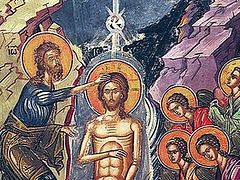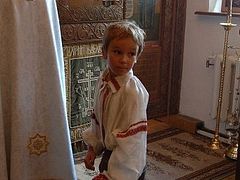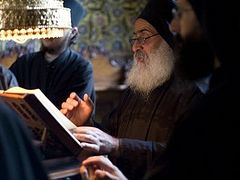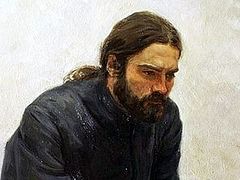On January 19, 1894, on the feast of the Theophany, Holy Hierarch Theophan peacefully reposed in the monastery of Vysha, having lived there for twenty-eight years, twenty-two of which were spent in strict reclusion. In his reclusion the saint was occupied with prayer, and the writing of his famous moral instructive, exegetical and translation work. The period of reclusion is one of the most hidden periods in the life of the Vysha ascetic, known only to the Lord. Out of his humility the saint wrote that in Vysha he is not “in reclusion, but in incarceration.”
In the words of the famous researcher of St. Theophan’s spiritual inheritance Fr. Georgiy (Tertyshnikov), “the time of reclusion is an important period; it could be said that it was the center of His Eminence Theophan’s life, for it was then that the larger part of his great works and ascetic labors manifested themselves in their fullest force.”
St. Theophan first saw his “most blessed” Vysha monastery when he was the ruling bishop of the Tambov cathedra. With his heart he felt there the outpouring of grace, and fell in love with the solitary, quiet monastery with the magnificent, inaccessible beauty of its surrounding nature. In 1862, when he appointed Abbot Arkady (Chestonov) to Vysha Monastery, he pronounced prophetically, “Go there, and later I too will come to you; we will start living together again.”
The holy hierarch himself always longed for solitude. It is well known that the decision to retire grew in him for a long time. As the saint himself commented, “I have it in my thoughts to serve God’s Church, only in a different way.” At his own request, on July 17, 1866 he was relieved of his duties as bishop of Vladimir diocese and appointed abbot of Vysha Hermitage. The saint departed Vladimir for Vysha on July 28 and arrived on August 3, 1866. In one of his letters he wrote about his first impressions: “It seems to me that Vysha is a most consoling and most blessed monastery!”
In September of the same year, the saint submitted his request to be relieved of the many cares of his abbatial duties, and his request was granted on September 19, 1866. According to the testimony of one of his contemporaries, “For him began a life without cares, a life suited to scholarly work and prayer. When he first began living in the hermitage, Bishop Theophan said to Abbot Arkady, “I intend to test myself in the ascetic labors of monasticism; I will go everyday to church and attend all the brothers’ services, and then I will tell you what is going on with me.” This test went on for five months. As the brothers remembered, “He would come to church, make prostrations according to the rule, stand in the altar in a specific place with complete attention, not relaxing his arms or legs, and start to pray. He would make bows at the waist, touching the ground with his hand, now rarely, now suddenly more often, or make lesser bows, or at times cease both the former and the latter.” All this would be done reverently, with concentration, and most often with his eyes closed, which, in his own words, “facilitated the concentration of all the senses, of abiding within; the standing with the mind and heart before the Lord.” The bishop would remain in this state of prayerful silence sometimes for a long while, and only the movement of the prayer rope through his fingers testified to the fact that mentally he never ceased to pronounce the words of the Jesus prayer.
At first St. Theophan settled into the abbot’s cell, but this room turned out not to be spacious enough for his voluminous library. Then the abbot of Vysha and a disciple of the holy hierarch Fr. Arcady (Chestonov) decided to build him a separate cell. In winter of 1866 construction began of a second floor made of wood over the stone prosphora bakery. St. Theophan’s new quarters were spacious and quite comfortable. The saint did not at first go into total solitude, but later went into complete reclusion, and stopped receiving visitors.
In the early days of his reclusion, St. Theophan would once in a while take walks in the woods when the weather was fair, during spring and summer. These walks would be interspersed with even more rare rides in a horse-drawn light carriage, accompanied by his cell attendant. In winter and summer the saint would walk daily on the balcony attached to his quarters on the north side. This balcony stretched across the entire length of the building and was guarded from view by a carved wooden grate, which the recluse had made himself.
In the saint’s cell there was always fresh air, and he dressed in clean and warm clothes. His table was simple, but large. His mental and physical work was done at specific times. This order, which the saint structured himself, facilitated his fruitful work.
A description of the saint’s cell is preserved in the article by an unknown author, “In the cell of the recluse,” published in April 1894 in the periodical, Soul-Profiting Reading. The uniqueness of these reminiscences consists in the fact that they were written just after the saint’s repose, when the contents of his cell were being disseminated. The entire atmosphere of his cell at the time was just as it was in his life. “The walls were wooden, without wallpaper, and a little darkened with age. All the furniture and the entire arrangement were simple and worn in the extreme. A closet with an angle square made of plain wood, valued at one ruble… A chest of drawers—two rubles… A simple, worn-out table… A couch made of birch wood, with tin seats—all valued at three rubles silver… Everything else was of the same ilk…”
As St. Theophan admitted in one of his letters, “Idleness is an evil buddy.” He had many things in his cell that testified to the his multi-faceted work: two tool boxes, lathe turning instruments, woodworking and bookbinding tools, a palette for painting and paintbrushes. There was a camera, a woodcarving press, a workbench, and lathes. A telescope. Two microscopes, an anatomical atlas, six geographical atlases—general, ecclesiastical, and Biblical. In his cell was one of the richest personal libraries of the time, as well as icons he painted himself; of the Crucifixion, the Resurrection of Christ, the Taking Down From the Cross, the Savior in the crown of thorns, the Theophany, of St. Tikhon of Zadonsk, St. Mitrophan of Voronezh, Sts. Anthony and Theodosius of the Kiev Caves, St. Alexander Nevsky, and others.
The saint liked to give little gifts that he made with his own hands to his spiritual children, sending them along with edifying instructions. “Greetings with the past and upcoming New Year. I am sorry for not answering for so long. Laziness overcame me. And now a hankering to make something came. Of these works—all turned on a lathe—are a small candle holder for the one who should pray the most; a salt cellar for matushka the nourisher; a perpetually burning candle (hiding a needle case) and an open needle case for the beauties, whose duty it is to work without sleeping.”
Very often the saint sent book knives he made himself. “I am enclosing two book knives (wooden blades I carved myself on the lathe): One is for your spouse, and the other is for you. It is rather hard to produce books, but book knives (carved on the lathe) are very easy to produce. So, I intend to replace the former with the latter.”
His time as a recluse was the most productive stage of his activity as a spiritual writer and theologian. In Vysha were written the saint’s better known moral instructions, exegetical and translation works. One of his most important works is the explanation of the Word of God, which became a significant contribution to Russian Biblical studies: the explanation of the Epistles of the Apostle Paul, the explanation of the 33rd and 118th Psalms and of the Six Psalms. During the period of reclusion the main translation projects were prepared: The Philokalia, Unseen Warfare, Ancient Monastic Rules, and others.
For these works, all the theological academies of the Russian Orthodox Church and the Berlin Brotherhood elected St. Theophan as an honorable member, and in 1890 the St. Petersburg Academy conferred upon him a doctorate in Theology.
Apart from his scholarly work, in his reclusion the saint conducted an extensive correspondence. Everyday he received from twenty to forty letters, and wrote detailed answers to all of them. The saint apprehended with great sensitivity his correspondents’ spiritual needs, and thoroughly answered their questions and dispelled their perplexities. He reacted energetically to the events occurring in the life of the Church and society, discussed the matter of translating the Bible into modern Russian language, and the events of the Russo-Turkic War of 1877 to 1878, as well as other events.
In his final years the saint prepared himself to receive the Great Schema tonsure, and sewed his own monastic garments for this. But the Lord ordained otherwise. St. Theophan reposed right after Divine Liturgy on the feast of the Theophany of the Lord, January 6/19, 1894.
Now St. Theophan’s relics, to which more and more pilgrims are coming, are located in the Kazan Cathedral of the Vysha Monastery of the Dormition.
St. Theophan’s house church in his now restored cell was consecrated in 2011. More than in any other place, here one can make contact with the recluse’s hidden mystery.
At the threshold of the 200th anniversary since the birth of St. Theophan, the Recluse of Vysha, which at the blessing of His Holiness Patriarch Kirill of Moscow and All Russia will be celebrated in 2015 by the entire Church, Vysha is regaining the same appearance that was so dear to the holy hierarch. He once wrote about his beloved monastery that, “only the Kingdom of Heaven could take its place.”










I am on New Calendar so I am studying about St. Theophan the Recluse of Vysha Monastery. I am looking for the town of Vysha and cannot find it. Article is saying that cell is now in Vladimir, but only monastery is for women, founded by princess. Was +Theophan’s cell moved from Visha to current location? Was original monastery destroyed by Bolsheviks? I would also like to know town of birth of Theophan and that location as well. Eventually I would like to visit this area of Old Russia. Who lived there 2000 years ago, Finns or Slavs?